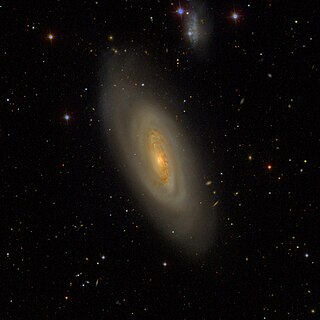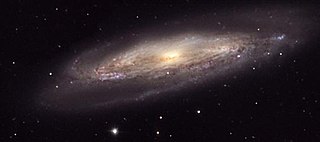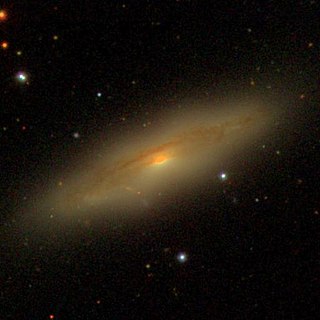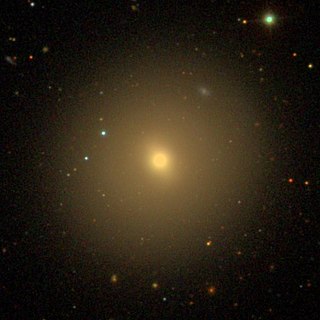
The Virgo Supercluster or the Local Supercluster is a mass concentration of galaxies containing the Virgo Cluster and Local Group, which in turn contains the Milky Way and Andromeda galaxies. At least 100 galaxy groups and clusters are located within its diameter of 33 megaparsecs. The Virgo SC is one of about 10 million superclusters in the observable universe and is in the Pisces–Cetus Supercluster Complex, a galaxy filament.

Coma Berenices is an ancient asterism in the northern sky which has been defined as one of the 88 modern constellations. It is located in the fourth galactic quadrant, between Leo and Boötes, and is visible in both hemispheres. Its name means "Berenice's Hair" in Latin and refers to Queen Berenice II of Egypt, who sacrificed her long hair as a votive offering. It was introduced to Western astronomy during the third century BC by Conon of Samos and was further corroborated as a constellation by Gerardus Mercator and Tycho Brahe. Coma Berenices is the only modern constellation named for a historic person.

Horologium is a faint constellation in the southern sky. It was devised by French astronomer Nicolas Louis de Lacaille in 1752, and it remains one of the 88 modern constellations. The constellation's brightest star is Alpha Horologii, an orange giant. R Horologii is a red giant Mira variable with one of the widest ranges in brightness known. Three star systems have exoplanets, while Nu Horologii has a debris disk.

The Virgo Cluster is a cluster of galaxies whose center is 53.8 ± 0.3 Mly away in the constellation Virgo. Comprising approximately 1300 member galaxies, the cluster forms the heart of the larger Virgo Supercluster, of which the Local Group is an outlying member. The Local Group actually experiences the mass of the Virgo Supercluster as the Virgocentric flow. It is estimated that the Virgo Cluster's mass is 1.2×1015M☉ out to 8 degrees of the cluster's center or a radius of about 2.2 Mpc.

Messier 90 is an intermediate spiral galaxy exhibiting a weak inner ring structure about 60 million light-years away in the constellation Virgo. It was discovered by Charles Messier in 1781.

SN 2004dj was the brightest supernova since SN 1987A at the time of its discovery.

Messier 98, also known as M98 or NGC 4192, is an intermediate spiral galaxy located about 44.4 million light-years away in the constellation Coma Berenices, about 6° to the east of the bright star Denebola. It was discovered by French astronomer Pierre Méchain on 15 March 1781, along with nearby M99 and M100, and was cataloged by French astronomer Charles Messier on 13 April 1781 in his Catalogue des Nébuleuses & des amas d'Étoiles. Messier 98 has a blue shift and is approaching us at about 140 km/s.

The Shapley Supercluster or Shapley Concentration is the largest concentration of galaxies in our nearby universe that forms a gravitationally interacting unit, thereby pulling itself together instead of expanding with the universe. It appears as a striking overdensity in the distribution of galaxies in the constellation of Centaurus. It is 650 million light years away (z=0.046).

The M96 Group is a group of galaxies in the constellation Leo. This group contains between 8 and 24 galaxies, including three Messier objects. The group is one of many groups that lies within the Virgo Supercluster.

NGC 2685 is a lenticular and polar ring Seyfert Type 2 galaxy in the constellation Ursa Major. It is about 50,000 light-years across and about 42 million light-years away from Earth. It is receding from Earth at 883 kilometers per second. It is an object of great scientific interest, because polar-ring galaxies are very rare galaxies. They are thought to form when two galaxies gravitationally interact with each other. "The bizarre configuration could be caused by the chance capture of material from another galaxy by a disk galaxy, with the captured debris strung out in a rotating ring. Still, observed properties of NGC 2685 suggest that the rotating ring structure is remarkably old and stable."

NGC 4206 is a spiral galaxy located about 70 million light-years away from Earth in the constellation of Virgo. The galaxy is visible with most moderate amateur telescopes at 13th magnitude. It was discovered by British astronomer William Herschel on 17 April 1784 and is a member of the Virgo Cluster.

NGC 4457 is a spiral galaxy located about 55 million light-years away in the constellation of Virgo. It is also classified as a LINER galaxy, a class of active galaxy defined by their spectral line emissions. NGC 4457 Is inclined by about 33°. It was discovered by astronomer William Herschel on February 23, 1784. Despite being listed in the Virgo Cluster Catalog as VCC 1145, NGC 4457 is a member of the Virgo II Groups which form an extension of the Virgo cluster.

NGC 4586 is a spiral galaxy located about 50 million light-years away in the constellation Virgo. The galaxy was discovered by astronomer William Herschel on February 2, 1786. Although listed in the Virgo Cluster Catalog, NGC 4586 is considered to be a member of the Virgo II Groups which form a southern extension of the Virgo cluster. NGC 4586 is currently in the process of infalling into the Virgo Cluster and is predicted to enter the cluster in about 500 million years.

NGC 4212 is a flocculent spiral galaxy with LINER activity located about 53 million light-years away in the constellation Coma Berenices. The galaxy was discovered by astronomer William Herschel on April 8, 1784 and was listed in the NGC catalog as NGC 4208. He then observed the same galaxy and listed it as NGC 4212. Astronomer John Louis Emil Dreyer later concluded that NGC 4208 was identical to NGC 4212. NGC 4212 is a member of the Virgo Cluster.

NGC 4267 is a barred lenticular galaxy located about 55 million light-years away in the constellation Virgo. It was discovered by astronomer William Herschel on Apr 17, 1784 and is a member of the Virgo Cluster.


















